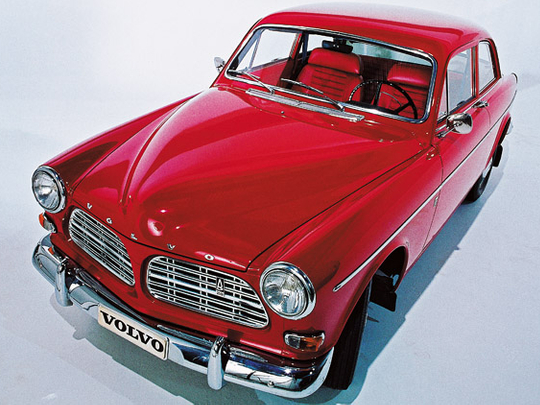
Volvo’s first post-war model, the PV series, became so popular that the Swedish carmaker sold more than half a million of these cars over their two-decade production run.
It was the first Volvo with a unibody construction, the first in two decades to be powered by a fuel-efficient four-cylinder engine and it carved itself a reputation for reliability too. Realising it was not replacing this popular model, Volvo set out on a long
and exhaustive development programme, which culminated in the 1956 Amazon.
Penned by young designer Jan Wilsgaard, the Amazon’s styling marked a major shift in direction for Volvo, featuring a split grille, curved pontoon wings, large wheels and two-tone colour scheme, making it a timeless design. Although several powertrain options were considered earlier on including a small V8 and a straight six, eventually the car came out with a newly developed 60bhp 1.6-litre in-line four designated the B16A.
Although the car was known as the Amazon in the home market, Volvo could not use that name outside Scandinavia, since a motorcycle manufacturer had patented the name on the Continent. Hence in other markets the Amazon was called the 121, with the first one introduced in September 1956 being a four-door saloon.
Demand was greater than expected and more than 5,000 cars were produced by December that year. Then in early 1958, a sport version of the Amazon called the 122S was introduced with a more powerful 85bhp engine with twin carburettors and a four-speed gearbox. And in August 1958, the Amazon, along with the PV 544, became the world’s first production car to feature front three-point seat belts as standard safety equipment.
A few years later, Volvo introduced a two-door version with the 130 model designation, a five-door estate under the 220 series and a new 1.8-litre B18 engine in two versions, one producing 75bhp and the twin-carb variant churning out 90bhp. The 123GT was the most powerful of all the different 120 series models offered, powered by a 115bhp, 2.0-litre engine. It also boasted a rev counter and a sporty three-spoke steering wheel among other standard features.
By the time production ended in 1970, Volvo had produced more than half a million units in all the three body types and the car had become hugely popular, not only at home and in Europe but in the Americas as well. Like most Volvos, the 120 series had a worldwide reputation for strength and reliability. Agreed, an old Volvo saloon or estate is hardly the car a typical classic collector would crave, but the Amazon deserves its place in history as the car that really made Volvo a household name beyond Europe, even before the P1800 did. For a small-engined car, the Amazon’s performance was on a par with some established sportscars from the same era. And with a body made of phosphate-treated steel that’s been given anti-corrosive treatment, these cars are more immune to rust than many of their contemporaries. And the best bit is the price. While the low-specced cars could be available for as little as Dh25K to Dh30K, you can get hold of a well-maintained 122S or a 123GT for around Dh140,000.











